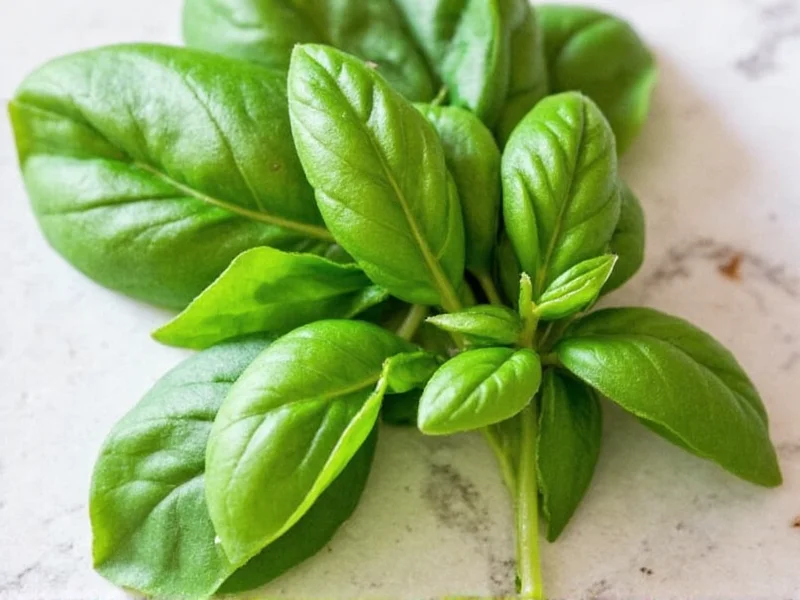Understanding the Fresh Basil to Dried Conversion Ratio
When substituting dried basil for fresh in recipes, understanding the precise conversion ratio is essential for balanced flavor. The 3:1 ratio (fresh to dried) isn't arbitrary—it's based on scientific principles of herb concentration. Fresh basil contains approximately 90% water, while dried basil has most moisture removed, concentrating the essential oils and flavor compounds.
Chefs and home cooks often make the mistake of using equal amounts when substituting, resulting in either overpowering or bland dishes. The concentrated nature of dried herbs means you need less to achieve equivalent flavor impact. This conversion principle applies to most leafy herbs, though exact ratios may vary slightly by variety.
Practical Fresh Basil Conversion Chart
| Fresh Basil | Dried Basil | Common Recipe Application |
|---|---|---|
| 1 cup packed | ⅓ cup | Pesto sauce, tomato sauces |
| ½ cup | 3 tablespoons | Marinades, dressings |
| ¼ cup | 1½ tablespoons | Roasted vegetables, soups |
| 1 tablespoon | 1 teaspoon | Finishing dishes, garnishes |
| 1 teaspoon | ¼ teaspoon | Delicate sauces, egg dishes |
Why Fresh and Dried Basil Aren't Interchangeable
The flavor profile difference between fresh and dried basil explains why precise conversion matters. Fresh basil offers bright, sweet notes with hints of anise and pepper, while dried basil develops earthier, more concentrated flavors with subtle mint undertones. The drying process changes the chemical composition—volatile oils evaporate while others concentrate.
For optimal results in your cooking:
- Add dried basil early in cooking to allow rehydration and flavor distribution
- Use fresh basil as a finishing touch to preserve delicate flavors
- When converting recipes, start with less dried basil and adjust to taste
- Consider the dish type—dried basil works better in long-simmered sauces while fresh excels in salads and garnishes
Storage Tips for Maximum Flavor Preservation
Proper storage significantly impacts dried basil quality and affects your fresh basil conversion accuracy. Store dried basil in airtight containers away from light, heat, and moisture. Glass jars with tight-sealing lids work best. Properly stored, dried basil maintains peak flavor for 6-12 months.
For best results when converting fresh to dried measurements:
- Use recently dried or purchased dried basil (older herbs lose potency)
- Crush dried basil between fingers before measuring to release oils
- Store dried basil away from strong-smelling spices that can transfer odors
- Check dried basil for color—vibrant green indicates freshness, while brownish tones suggest degradation
Cooking Applications and Substitution Guidance
Understanding when to use each form enhances your culinary results. For Italian tomato sauces requiring long simmering times, dried basil often provides more consistent flavor distribution. In contrast, fresh basil shines in caprese salads, pesto, and as a finishing garnish where its bright flavor remains intact.
When converting recipes that call for fresh basil to dried:
- Calculate the base conversion using the 3:1 ratio
- Consider cooking time—longer cooking may require slightly less dried basil
- Adjust for personal taste preferences after initial conversion
- Remember that different drying methods (air-dried vs. oven-dried) affect potency
Professional chefs often recommend starting with 25% less than the calculated conversion when using dried basil in delicate dishes, then adjusting to taste. This approach prevents overpowering the dish while accounting for variables in herb quality and storage conditions.
Common Conversion Mistakes to Avoid
Many home cooks make critical errors when substituting dried for fresh basil. The most common mistake is using equal measurements, which typically results in overly strong, sometimes bitter flavors. Another frequent error involves improper timing—adding dried basil too late in the cooking process prevents proper flavor integration.
For accurate fresh to dried basil substitution in your recipes:
- Never substitute 1:1—always use the 3:1 conversion ratio as your starting point
- Account for recipe moisture content—drier recipes may need slightly more dried basil
- Consider the dish's complexity—simple dishes require more precise measurements
- When in doubt, start with less and add gradually during cooking











 浙公网安备
33010002000092号
浙公网安备
33010002000092号 浙B2-20120091-4
浙B2-20120091-4